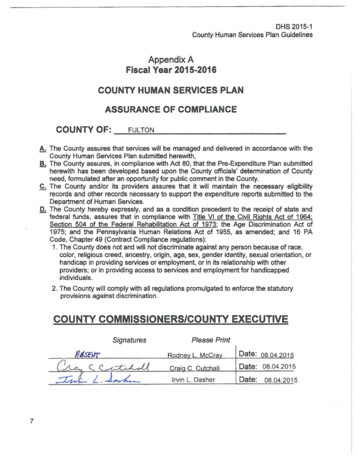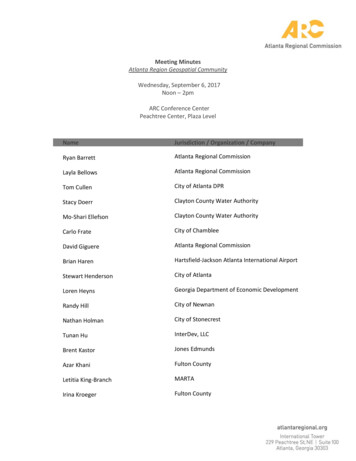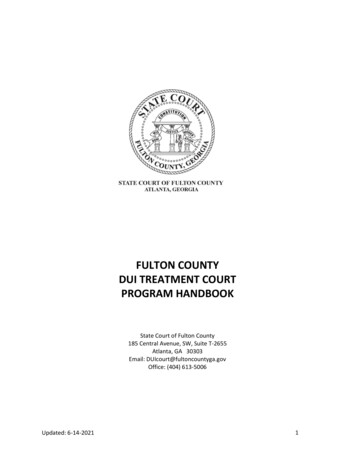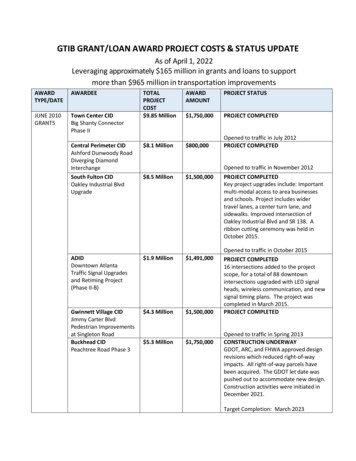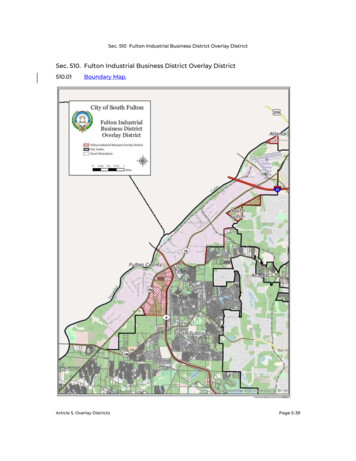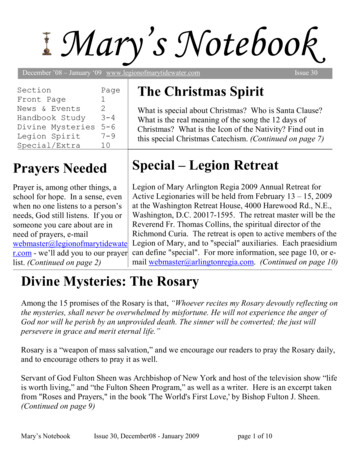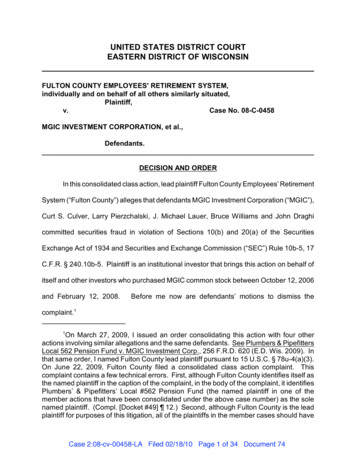
Transcription
UNITED STATES DISTRICT COURTEASTERN DISTRICT OF WISCONSINFULTON COUNTY EMPLOYEES' RETIREMENT SYSTEM,individually and on behalf of all others similarly situated,Plaintiff,v.Case No. 08-C-0458MGIC INVESTMENT CORPORATION, et al.,Defendants.DECISION AND ORDERIn this consolidated class action, lead plaintiff Fulton County Employees’ RetirementSystem (“Fulton County”) alleges that defendants MGIC Investment Corporation (“MGIC”),Curt S. Culver, Larry Pierzchalski, J. Michael Lauer, Bruce Williams and John Draghicommitted securities fraud in violation of Sections 10(b) and 20(a) of the SecuritiesExchange Act of 1934 and Securities and Exchange Commission (“SEC”) Rule 10b-5, 17C.F.R. § 240.10b-5. Plaintiff is an institutional investor that brings this action on behalf ofitself and other investors who purchased MGIC common stock between October 12, 2006and February 12, 2008.Before me now are defendants’ motions to dismiss thecomplaint.11On March 27, 2009, I issued an order consolidating this action with four otheractions involving similar allegations and the same defendants. See Plumbers & PipefittersLocal 562 Pension Fund v. MGIC Investment Corp., 256 F.R.D. 620 (E.D. Wis. 2009). Inthat same order, I named Fulton County lead plaintiff pursuant to 15 U.S.C. § 78u-4(a)(3).On June 22, 2009, Fulton County filed a consolidated class action complaint. Thiscomplaint contains a few technical errors. First, although Fulton County identifies itself asthe named plaintiff in the caption of the complaint, in the body of the complaint, it identifiesPlumbers’ & Pipefitters’ Local #562 Pension Fund (the named plaintiff in one of themember actions that have been consolidated under the above case number) as the solenamed plaintiff. (Compl. [Docket #49] ¶ 12.) Second, although Fulton County is the leadplaintiff for purposes of this litigation, all of the plaintiffs in the member cases should haveCase 2:08-cv-00458-LA Filed 02/18/10 Page 1 of 34 Document 74
I. BACKGROUNDThis case involves a somewhat complicated series of events involving two different,but affiliated, companies – MGIC and Credit-Based Asset Servicing and Securitization (“CBASS”) – both of which suffered severe losses as a result of the subprime mortgage crisisthat materialized in 2007. MGIC, through its principal subsidiary, is an insurer of residentialhome mortgages. During the class period, it insured a fair number of subprime mortgagesand other types of risky mortgages. MGIC also owned a 46% interest in C-BASS, a jointventure of MGIC and another mortgage insurer, Radian Group Inc. (“Radian”). Like MGIC,Radian owned a 46% interest in C-BASS. C-BASS specialized in purchasing subprimesingle-family residential mortgages and packaging them into mortgage-backed securities.Plaintiff alleges that as the subprime crisis began to unfold, MGIC, three executivesat MGIC (Curt Culver, J. Michael Lauer and Larry Pierzchalski) and two executives at CBASS (Bruce Williams and John Draghi) all made false and misleading statementsdesigned to mask the true impact of the crisis on the companies’ businesses. Thesestatements can be divided into three categories. In the first category are statements aboutMGIC’s underwriting practices during the time period leading up to the subprime crisis.been identified as named plaintiffs in the consolidated class action complaint. FultonCounty’s failure to include all of the plaintiffs in the member cases as named plaintiffs inthe consolidated class action complaint has caused defendants to argue that, since FultonCounty did not purchase MGIC stock after February 28, 2007, it lacks standing to assertclaims based on statements made after that date. However, Wayne County – a namedplaintiff in one of the member cases – did purchase MGIC stock after February 28, 2007,and thus it has standing to assert claims based on defendants’ later statements. BecauseWayne County should have been identified as a named plaintiff in the consolidated classaction complaint, and because the complaint could be amended to add Wayne County asa named plaintiff, I will not dismiss the claims based on statements made after February28, 2007 for lack of standing.2Case 2:08-cv-00458-LA Filed 02/18/10 Page 2 of 34 Document 74
Plaintiff argues that such statements were false because they implied that MGIC had beenfollowing “superior” underwriting practices when, in fact, its underwriting was lax. In thesecond category are statements about the mortgages that MGIC insured during 2005 and2006.As the subprime crisis developed, an unusually large percentage of thosemortgages went into default and eventually resulted in claims that MGIC had to pay.Plaintiff alleges that MGIC’s executives knew early in the class period that these claimswere coming but made statements designed to mislead investors into thinking that the2005 and 2006 business was problem-free.The final category of statements concerned C-BASS. Plaintiff alleges that both theMGIC defendants and the C-BASS defendants misled investors by failing to discloseduring an investor conference call held on July 19, 2007 that C-BASS had received 145million in margin calls between July 1st and the date of the call.2 In the days following thisconference call, C-BASS received another 470 million in margin calls, and C-BASS didnot have the liquidity needed to pay them. This eventually led MGIC to decide that itsentire investment in C-BASS (about 516 million) had been materially impaired.Plaintiff alleges that defendants’ fraudulent statements and failures to disclosecaused MGIC’s stock to trade at artificially high prices during the class period. Plaintiff didnot purchase C-BASS securities, and thus any statements about C-BASS are actionableonly insofar as they affected MGIC’s stock price.2C-BASS financed its business primarily by borrowing money from various financialinstitutions, using its portfolio of mortgages as collateral. As the subprime crisis developedand financial institutions began to doubt the value of these mortgages, they made “margincalls” demanding that C-BASS either put up additional collateral or pay cash to make upthe difference.3Case 2:08-cv-00458-LA Filed 02/18/10 Page 3 of 34 Document 74
Before turning to an analysis of plaintiff’s claims, I must provide some additionalbackground concerning MGIC’s business. This background relates to all of plaintiff’sclaims. I note that in addition to this background, I will provide further details, as needed,in the course of my analysis of plaintiff’s specific claims in the discussion section thatfollows.A.The Nature of Private Mortgage InsurancePrivate mortgage insurance, or “PMI,” insures the owner of a residential firstmortgage loan against the borrower’s default. It covers unpaid loan principal, delinquentinterest, and certain expenses associated with the default and subsequent foreclosure.One of its major roles is to allow mortgage lenders to sell riskier mortgages to third partiessuch as Fannie Mae and Freddie Mac. Due to governmental restrictions on how much riskFannie and Freddie can assume, these entities cannot purchase a mortgage with a loan-tovalue ratio higher than 80% – i.e., mortgages in which the borrower did not make a downpayment equivalent to 20% of the loan’s value. Mortgage insurance generally limits therisk of loss in connection with a default to 80% of the loan’s value, even if the loan-to-valueratio is greater than 80%. It thus allows lenders to sell loans to Fannie and Freddie evenif the borrower did not put 20% down. In exchange for assuming the excess default risk,mortgage insurers charge premiums. The premium charged varies depending on theamount of risk assumed, with higher premiums charged on riskier loans.B.MGIC’s Book of BusinessDuring the class period, MGIC insured mortgages through two principal channels.In the first channel, known as the “flow” channel, MGIC insured individual mortgages on4Case 2:08-cv-00458-LA Filed 02/18/10 Page 4 of 34 Document 74
a one-by-one basis. In the second channel, known as the “bulk” channel, MGIC insureda substantial number of mortgages that had been pooled and packaged into securities.MGIC referred to this insurance as its “Wall Street bulk” insurance. MGIC also used itsbulk channel to insure individual loans that were submitted to it on a portfolio basis. MGICeventually began referring to this bulk business as its “remaining bulk,” to distinguish it fromthe more volatile Wall Street bulk business. A substantial portion of MGIC’s Wall Streetbulk business consisted of insuring subprime and Alt-A loans. As the parties use theterms, subprime loans are those made to borrowers with low credit scores, and Alt-A loans(also known as “stated income” or “reduced doc” loans) are loans in which the lender doesnot obtain documentation verifying the representations made by the borrower concerninghis or her income.C.MGIC’s Intent to Merge with Radian and Sell Its Interest in C-BASSOn February 6, 2007, MGIC and Radian announced that they planned to merge witheach other through a stock-for-stock exchange scheduled to close during the fourth quarterof 2007. The merger plan assumed that MGIC and Radian would reduce their joint interestin C-BASS to less than 50%. The reason for this was that if the post-merger entitycontinued to own almost all of C-BASS, the combined entity would have been required tocarry C-BASS’s assets and liabilities on its balance sheet, which would have threatenedthe combined entity’s credit rating. In order to reduce its interest in C-BASS and facilitatethe merger, MGIC planned to sell much of that interest. Besides facilitating the merger,MGIC’s sale of its interest in C-BASS was designed to raise 1.75 billion in cash, whichMGIC planned to use to repurchase some of its shares. This share repurchase was5Case 2:08-cv-00458-LA Filed 02/18/10 Page 5 of 34 Document 74
designed to raise MGIC’s stock price. Ultimately, because of the problems that developedat C-BASS at the end of July 2007, MGIC and Radian abandoned their merger plans.II. DISCUSSIONPlaintiff alleges two theories of liability: (1) securities fraud under Section 10(b) ofthe Securities Exchange Act and Rule 10b-5 against MGIC and the individual defendants,and (2) control person liability under Section 20(a) of the Securities Exchange Act againstthe individual defendants. Both the MGIC defendants (MGIC, Culver, Lauer andPierzchalski) and the C-BASS defendants (Williams and Draghi) have moved to dismissthe consolidated class action complaint for failure to state a claim on which relief may begranted, Fed. R. Civ. P. 12(b)(6), failure to plead fraud with particularity, Fed. R. Civ. P.9(b), and failure to comply with the heightened pleading requirements of the PrivateSecurities Litigation Reform Act (“PSLRA”), 15 U.S.C. § 78u-4(b)(1) & (2).A.Pleading Standards for Section 10(b) ClaimsSection 10(b) of the Securities Exchange Act forbids the use or employment of anydeceptive device in connection with the purchase or sale of any security. 15 U.S.C.§ 78j(b). Rule 10b-5 forbids the making of any “untrue statement of a material fact” or theomission of any material fact needed to make the statements not misleading. 17 C.F.R.§ 240.10b-5. To satisfactorily plead a violation of Section 10(b) and Rule 10b-5, a plaintiffmust allege facts indicating that (1) defendants made a false statement or omission (2) ofmaterial fact (3) with scienter (4) in connection with the purchase or sale of securities (5)upon which plaintiff justifiably relied and (6) the false statement or omission proximatelycaused the plaintiff’s damages. Makor Issues & Rights, Ltd. v. Tellabs, Inc., 437 F.3d 588,6Case 2:08-cv-00458-LA Filed 02/18/10 Page 6 of 34 Document 74
595 (7th Cir. 2006) (Makor I), vacated and remanded on other grounds, 551 U.S. 308(2007).To plead a false statement of material fact, a plaintiff must “specify each statementthat is allegedly misleading, the reasons why it is so, and, if based on information andbelief, what specific facts support that information and belief.” Id. (citing 15 U.S.C. § 78u4(b)(1)). The facts alleged must be “sufficient to support a reasonable belief as to themisleading nature of the statement or omission.” Id. (internal quotation marks omitted).A statement is material if it is likely that a reasonable purchaser or seller of asecurity (1) would consider it important in deciding whether to buy or sell the security or (2)would have viewed the total mix of information made available to be significantly alteredby the statement. Id. at 596. However, mere puffery is not actionable under Rule 10b-5.“If the statement amounts to vague aspiration or unspecific puffery, it is not material.”Eisenstadt v. Centel Corp., 113 F.3d 738, 746 (7th Cir. 1997).Scienter involves a “mental state embracing an intent to deceive, manipulate, ordefraud.” Ernst & Ernst v. Hochfelder, 425 U.S. 185, 194 n.12 (1976). Misstatements oromissions made recklessly are also made with scienter. To plead scienter, a complaintmust “state with particularity the facts giving rise to a strong inference that the defendantacted with the required state of mind.” 15 U.S.C. § 78u-4(b)(2). In determining whetherplaintiff’s allegations are adequate to give rise to a strong inference of scienter, I acceptthe allegations as true and consider the complaint in its entirety as well as other sourcesthat I would ordinarily review, such as documents attached to the complaint or thosesubject to judicial notice. Tellabs v. Makor Issues & Rights, Ltd., 551 U.S. 308, 322 (2007).I then ask whether the allegations taken collectively establish a “strong inference of7Case 2:08-cv-00458-LA Filed 02/18/10 Page 7 of 34 Document 74
scienter.” Id. at 323. In doing so, I weigh plausible nonculpable inferences againstinferences favoring plaintiffs’ claim. Id. at 323-24. The inference favoring plaintiff’s claim“need not be irrefutable, . . . of the ‘smoking-gun’ genre, or even the most plausible ofcompeting inferences.” Id. at 324. Rather, plaintiff’s complaint survives if a “reasonableperson would deem the inference of scienter cogent and at least as compelling as anyplausible opposing inference one could draw from the facts alleged.” Id.B.Plaintiff’s Allegations1.Allegations Concerning MGIC’s UnderwritingAs noted, the first category of allegedly fraudulent statements concerns MGIC’sunderwriting standards. As used in the complaint, “underwriting” refers to the process bywhich MGIC would decide whether to insure a mortgage and what the premiums shouldbe.Plaintiff contends that, as the subprime crisis began to unfold,3 MGIC madestatements that were designed to assure the market that MGIC’s “superior” underwritingpractices had “insulated” it from the developing crisis. (Pl.’s Br. in Opp. [Docket #65] at24.) Plaintiff contends that these statements were false and misleading because, in fact,MGIC had employed loose underwriting standards and insured risky subprime and Alt-Amortgages.Plaintiff identifies the following statements in support of this claim:(1) During a February 6, 2007 conference call, in discussing the merger withRadian, Culver (MGIC’s CEO) stated that with respect to “the loss side” ofthe business, “both [MGIC’s and Radian’s] portfolios are well-managed” and“well controlled.”3The subprime crisis began to seriously affect financial markets in February 2007,when HSBC, the world’s largest bank, reported major subprime losses. (Compl. [Docket#49] ¶ 54.)8Case 2:08-cv-00458-LA Filed 02/18/10 Page 8 of 34 Document 74
(2) In early March 2007, Culver met with analysts at Keefe, Bruyette &Woods, Inc. (“KBW”) and, as indicated by the subsequent KBW analystreport, “stressed” that MGIC had protected itself with “focused underwritingand risk layering in its bulk transactions.” The KBW report stated that it was“[t]his underwriting and other qualitative considerations” that “reinforce[d][KBW’s] belief and management’s that the [mortgage insurance] exposureis not a proxy of the broader mortgage credit market” and noted that “Mr.Culver’s tone regarding MGIC . . . was the most bullish [KBW had] heard inseveral years.”(3) On March 9, 2007, Culver, Lauer (MGIC’s CFO) and Pierzchalski(MGIC’s Vice President of Risk Management) met with Citigroup analysts.The analysts’ subsequent report stated: “In our meetings, managementexuded confidence in [MGIC’s] positioning vis-à-vis the recent credit issuesthat have arisen in subprime mortgages. In particular, [MGIC] has not writteninsurance on most of the loans that were apparently subject to laxunderwriting standards during the second half of 2005 and the first half of2006. In fact, the CEO stated that a lot of the ‘goofy’ stuff was done in orderto avoid mortgage insurance products in general.”(4) In the same meeting, Culver, Lauer and Pierzchalski “indicated that[MGIC’s] credit outlook was unchanged,” and the analysts reported thatMGIC had “anticipated much of the recent credit deterioration” and had“avoided the ‘toxic’ exposures.”(5) Also during the March 9, 2007 meeting, Culver, Lauer and Pierzchalskiindicated that MGIC only worked with Alt-A issuers “where it was able to getthe right risk profile and pricing.”(6) During an April 11, 2007 earnings conference call, Culver stated: “Thesubprime business continues to be a hot topic, particularly the 2006 bookand rightly so given the many credit practices that were abused last year.Our industry and our company did not participate a great deal in thesepractices.”(Br. in Supp. [Docket #65] at 24-25.)An initial problem with plaintiff’s claim is that the quoted statements do not state orimply that MGIC employed “superior” underwriting practices or that those practices had“insulated” MGIC from the subprime crisis. None of the statements uses the word“superior” or any other adjective that would cause a reasonable investor to believe that9Case 2:08-cv-00458-LA Filed 02/18/10 Page 9 of 34 Document 74
MGIC’s underwriting was better than the underwriting employed by others in the industry.4Nor does any statement suggest that MGIC was “insulated” from the losses affecting otherparticipants in the subprime market. Thus, taken as a whole, the alleged statements donot support a reasonable belief that MGIC misled investors into thinking that MGICemployed superior underwriting practices that would insulate it from losses in the subprimemarket.To be sure, some of the above statements cast MGIC’s underwriting practices in apositive light and suggested that MGIC’s underwriting would help it deal with the issuesemerging in the subprime markets. However, viewing each of the six statements closelyand in light of the circumstances in which it was made, I find that the statements are notactionable because most of them were immaterial. To the extent that some of them couldbe considered material, I find that they were not misleading. I address each statement inturn.(1) The first statement quoted above occurred during a February 6, 2007 conferencecall about the MGIC-Radian merger. During that conference, an analyst asked Culverabout the strategic rationale for the merger, noting that the mortgage market had not beenin very good shape during the past few quarters.As part of his answer, Culveracknowledged that paid claims were increasing at each company, but added that hethought that both companies’ portfolios were “well managed” and “well controlled.” (Chester4Regarding plaintiff’s use of the word “industry,” it is not clear whether plaintiffmeans the mortgage-insurance industry or the entire mortgage industry. In any event,MGIC did not state that its underwriting was superior to either the underwriting employedby other mortgage insurers or others in the mortgage industry.10Case 2:08-cv-00458-LA Filed 02/18/10 Page 10 of 34 Document 74
Decl. [Docket #62] Ex. 9 at 18-19.) Culver went on to describe what he thought were thebenefits of combining the two companies.In his statement, Culver did not say anything about MGIC’s underwriting standards,but plaintiff argues that when Culver stated that the companies’ portfolios were “wellmanaged” and “well controlled” he was implying that both companies employed superiorunderwriting practices. However, Culver’s use of the terms “well managed” and “wellcontrolled” was so vague that it is hard to know what he was talking about. Because thisstatement was so vague, no reasonable investor would have considered it important indeciding whether to buy or sell MGIC stock. Thus, even if it could be considered false ormisleading, this statement was not material.(2) The second statement was not made by MGIC or its executives. Instead,analysts made this statement in a report they prepared after meeting with Culver andanother executive of MGIC who is not a defendant in this case. Most of this statementconsists of conclusions that the analysts drew after meeting with Culver, rather than directquotes from Culver, and thus this statement may not be attributable to Culver or MGIC.5But even if it could be attributed to Culver or MGIC, it is not actionable, for the reasonsexplained below.The heart of the statement is the following sentence: “The company noted thatfocused underwriting and risk layering in its bulk transactions continues to differentiate the5See, e.g., Southland Sec. Corp. v. Inspire Ins. Solutions Inc., 365 F.3d 353, 373(5th Cir. 2004) (“Generally, securities issuers are not liable for statements or forecastsdisseminated by securities analysts or third parties unless they have sufficiently entangledthemselves with the analysts' forecasts so as to render those predictions attributable to theissuers.” (Internal citations and alterations omitted)).11Case 2:08-cv-00458-LA Filed 02/18/10 Page 11 of 34 Document 74
credit performance in its insured portion of a transaction versus the performance of theoverall transaction.” (Compl. [Docket #49] ¶ 210.) Plaintiff argues that the phrase “focusedunderwriting and risk layering” conveyed the false impression that MGIC’s underwriting wasso superior to others’ that it would insulate MGIC from subprime losses. However, the fullsentence reveals that plaintiff’s interpretation is not a plausible interpretation of thestatement.To understand why, some further background on MGIC’s underwritingpractices is necessary.The statement was made in reference to MGIC’s Wall Street bulk insurance – i.e,insurance on mortgages that had been packaged into securities. When MGIC wrote thiskind of insurance, it did not automatically insure every loan that had been included in thesecurity. Rather, during the underwriting process, MGIC selected specific loans within thepool and insured only those loans. Thus, as the complaint alleges, when a securitizationstarted to lose value, “MGIC’s loss experience did not necessarily mirror that of the overallsecuritization transaction.” (Compl. [Docket #49] ¶ 31.)With this background in mind, it is clear that the statement that the analystsattributed to MGIC was, based on the allegations in the complaint, true. MGIC had simplystated that, due to its ability to insure only the loans selected during its underwritingprocess, MGIC’s loss experience would not necessarily mirror the loss experience of theoverall securitization.To be sure, the phrase “focused underwriting” conveys theimpression that MGIC’s underwriting would result in a better loss experience. However,this phrase is so vague that it cannot be deemed material. And even if it were material, theallegations in the complaint do not create a reasonable belief that it was false ormisleading. Although the complaint contains numerous allegations from confidential12Case 2:08-cv-00458-LA Filed 02/18/10 Page 12 of 34 Document 74
witnesses stating that MGIC had loosened its underwriting standards and insured riskyloans as part of its bulk business, no witness claims to know anything about the selectioncriteria that MGIC employed when picking mortgages out of a securitization pool. Thus,as far as the complaint reveals, MGIC may have engaged in “focused underwriting”(whatever that means) when it identified the segment of a mortgage-backed security thatit would insure.(3) The third statement was also made by analysts rather than MGIC or itsexecutives and therefore may not be attributable to MGIC. See supra note 5. But again,even if it is attributable to MGIC, it is not actionable. The full statement reads as follows:In our meetings, management exuded confidence in [MGIC’s] positioning visa-vis the recent credit issues that have arisen in subprime mortgage. Inparticular, [MGIC] has not written insurance on most of the loans that wereapparently subject to lax underwriting standards during the second half of2005 and the first half of 2006. In fact, the CEO [i.e., Culver] stated that alot of “goofy” stuff was done by lenders over the past few years in order toavoid mortgage insurance products in general. He indicated that themortgage insurance industry didn’t have a chance to insure a lot of thebusiness that was getting done, because it was done with unacceptableunderwriting or with “piggybacks” (home equity second lien loans).(Compl. [Docket #49] ¶ 212 (sixth quoted par.).) Plaintiff considers MGIC’s statement thatit “ha[d] not written insurance on most of the loans that were apparently subject to laxunderwriting standards during the second half of 2005 and the first half of 2006" to be falsebecause plaintiff’s confidential witnesses describe instances in which MGIC insuredsubprime and Alt-A loans.However, MGIC did not state that it had not written any insurance on subprime orAlt-A loans or loans that were subject to lax underwriting standards. Rather, the statementwas that MGIC had not written insurance on most of those kinds of loans. What “most”13Case 2:08-cv-00458-LA Filed 02/18/10 Page 13 of 34 Document 74
means in this context is vague and therefore cannot be deemed material. Further, thisvague use of the word “most” must be considered along with the fact that, in the samereport, analysts identified the precise extent to which MGIC had insured subprime and AltA mortgages. Specifically, the report stated that MGIC’s exposure to subprime and Alt-Amortgages was “ 14 billion of risk in force,” and that “Alt-A comprised 42% of [MGIC’s] bulkbusiness last year, but 94% of flow and 65% of bulk loan risk in force in 2006 had FICOscores of at least 620 (up from 60% in 2005).” (Compl. [Docket #49] ¶ 212 (quoted pars.under heading “Framing MTG’s Exposure”).) Thus, to the extent that investors consideredMGIC’s statement that it had avoided “most” of the loans that were subject to laxunderwriting important, they could have evaluated that statement in light of the moredetailed information made available in the same report. Considering the report as a whole,then, MGIC’s statement cannot be considered false or misleading.(4) The key language in the fourth statement – which again was written by analystsrather than MGIC – is the following: “Regarding recent subprime credit concerns . . . , we[i.e., the analysts] believe [MGIC] had anticipated much of the downturn in subprimemortgage (albeit not the rapid pace of the decline) and had avoided the more ‘toxic’ andaggressively underwritten loans at subprime monolines,[6] including New Century, Fremont,and Ownit.” (Compl. [Docket #49] ¶ 212 (third quoted par.).)Initially, I note that this statement is merely a statement of the analysts’ belief, nota direct quote of a statement made by MGIC. Further, the report does not quote anystatements made by MGIC that could have reasonably led the analysts to form this belief.6“Monoline,” as used in this context, means an entity that specializes in one type ofloan, such as subprime loans having 100% loan-to-value ratios.14Case 2:08-cv-00458-LA Filed 02/18/10 Page 14 of 34 Document 74
The only words attributed to MGIC in the paragraph containing this statement are thefollowing: “[MGIC] reiterated its 2007 credit guidance, indicating that nothing has changedin the company’s portfolio over the past two months since 2007 guidance was provided (on[MGIC’s] 4Q06 earnings conference call).” (Id.) How the analysts extracted from thisstatement a belief that MGIC had “anticipated much of the downturn in subprime mortgage”and “avoided the more ‘toxic’ and aggressively underwritten loans” is unclear, and thus thecomplaint provides no basis for concluding that false statements by MGIC were the sourceof this belief. Further, even if it could be inferred that MGIC executives stated that they hadanticipated “much” of the subprime downturn and avoided the more “toxic” loans fromentities such as New Century, Fremont and Ownit, no allegations in the complaint createa reasonable belief that these statements were false and material. Saying that one hasanticipated “much” of the subprime downturn is vague puffery, and the complaint does notallege that MGIC had, in fact, insured the more toxic loans from entities such as NewCentury, Fremont and Ownit.(5) The fifth statement was again made by analysts rather than MGIC or itsexecutives: “[MGIC] continued to write bulk business to Alt-A issuers, where it was able toget the right risk profile and pricing – Alt-A comprised 42% of [MGIC’s] bulk business lastyear, but 94% of flow and 65% of bulk loan risk in force in 2006 had FICOs of at least 620(up from 60% in 2005).” (Compl [Docket #49] ¶ 212 (eighth quoted par.).) Plaintiffcontends that this statement was false because MGIC insured Alt-A loans even when itwas unable to get the right risk profile and pricing. However, the phrase “right risk profileand pricing” is extremely vague and therefore no reasonable investor would consider itimportant in deciding whether to buy or sell MGIC stock. Further, to the extent this phrase15Case 2:08-cv-00458-LA Filed 02/18/10 Page 15 of 34 Document 74
has meaning, the analysts seem to have defined the “right risk profile” as loans in whichthe borrowers had “FICOs of at least 620.”Thus, the statement appears to beemphasi
the merger, MGIC planned to sell much of that interest. Besides facilitating the merger, MGIC's sale of its interest in C-BASS was designed to raise 1.75 billion in cash, which MGIC planned to use to repurchase some of its shares. This share repurchase was Case 2:08-cv-00458-LA Filed 02/18/10 Page 5 of 34 Document 74
